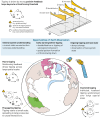Monitoring the Multiple Stages of Climate Tipping Systems from Space: Do the GCOS Essential Climate Variables Meet the Needs?
- PMID: 40417377
- PMCID: PMC12095353
- DOI: 10.1007/s10712-024-09866-4
Monitoring the Multiple Stages of Climate Tipping Systems from Space: Do the GCOS Essential Climate Variables Meet the Needs?
Abstract
Many components of the Earth system feature self-reinforcing feedback processes that can potentially scale up a small initial change to a fundamental state change of the underlying system in a sometimes abrupt or irreversible manner beyond a critical threshold. Such tipping points can be found across a wide range of spatial and temporal scales and are expressed in very different observable variables. For example, early-warning signals of approaching critical transitions may manifest in localised spatial pattern formation of vegetation within years as observed for the Amazon rainforest. In contrast, the susceptibility of ice sheets to tipping dynamics can unfold at basin to sub-continental scales, over centuries to even millennia. Accordingly, to improve the understanding of the underlying processes, to capture present-day system states and to monitor early-warning signals, tipping point science relies on diverse data products. To that end, Earth observation has proven indispensable as it provides a broad range of data products with varying spatio-temporal scales and resolutions. Here we review the observable characteristics of selected potential climate tipping systems associated with the multiple stages of a tipping process: This includes i) gaining system and process understanding, ii) detecting early-warning signals for resilience loss when approaching potential tipping points and iii) monitoring progressing tipping dynamics across scales in space and time. By assessing how well the observational requirements are met by the Essential Climate Variables (ECVs) defined by the Global Climate Observing System (GCOS), we identify gaps in the portfolio and what is needed to better characterise potential candidate tipping elements. Gaps have been identified for the Amazon forest system (vegetation water content), permafrost (ground subsidence), Atlantic Meridional Overturning Circulation, AMOC (section mass, heat and fresh water transports and freshwater input from ice sheet edges) and ice sheets (e.g. surface melt). For many of the ECVs, issues in specifications have been identified. Of main concern are spatial resolution and missing variables, calling for an update of the ECVS or a separate, dedicated catalogue of tipping variables.
Keywords: Earth Observation; Essential Climate Variables; GCOS; Tipping points.
© The Author(s) 2025.
Conflict of interest statement
Conflict of interestThe authors declare no competing interests.
Figures




Similar articles
-
Physics-based early warning signal shows that AMOC is on tipping course.Sci Adv. 2024 Feb 9;10(6):eadk1189. doi: 10.1126/sciadv.adk1189. Epub 2024 Feb 9. Sci Adv. 2024. PMID: 38335283 Free PMC article.
-
Extreme Events Contributing to Tipping Elements and Tipping Points.Surv Geophys. 2025;46(2):375-420. doi: 10.1007/s10712-024-09863-7. Epub 2024 Nov 16. Surv Geophys. 2025. PMID: 40417379 Free PMC article. Review.
-
Permafrost and Freshwater Systems in the Arctic as Tipping Elements of the Climate System.Surv Geophys. 2025;46(2):303-326. doi: 10.1007/s10712-025-09885-9. Epub 2025 May 2. Surv Geophys. 2025. PMID: 40417378 Free PMC article. Review.
-
Risk of tipping the overturning circulation due to increasing rates of ice melt.Proc Natl Acad Sci U S A. 2021 Mar 2;118(9):e2017989118. doi: 10.1073/pnas.2017989118. Proc Natl Acad Sci U S A. 2021. PMID: 33619095 Free PMC article.
-
Resilience Indicators for Tropical Rainforests in a Dynamic Vegetation Model.Glob Chang Biol. 2024 Dec;30(12):e17613. doi: 10.1111/gcb.17613. Glob Chang Biol. 2024. PMID: 39641149 Free PMC article.
References
-
- Armstrong McKay DI, Staal A, Abrams JF, Winkelmann R, Sakschewski B, Loriani S, Fetzer I, Cornell SE, Rockström J, Lenton TM (2022) Exceeding 1.5°C global warming could trigger multiple climate tipping points. Science. 10.1126/science.abn7950 - PubMed
-
- Ashwin P, Wieczorek S, Vitolo R, Cox P (2012) Tipping points in open systems: bifurcation, noise-induced and rate-dependent examples in the climate system. Phil Trans R Soc A 370:1166–1184. 10.1098/rsta.2011.0306 - PubMed
Publication types
LinkOut - more resources
Full Text Sources
Miscellaneous
